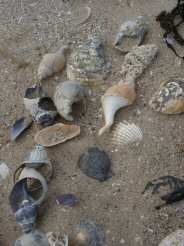Milliways Mail order shop: Advice, tips and tricks.
PLANTS FOR SEASIDE & COASTAL GARDENS:
Many plants that succeed in costal locations have evolved adaptations to enable them tolerate the worst effects of the environment.
Plants that have gray or tough leathery leaves or are succulent, dwarf ground cover plants and hairy leafed plants survive best in these conditions. You can also be sure that a plant with "littoralis" (meaning of the shore) or "maritima" in its name will be in its element in the costal garden. There are many to choose from, you need not fear having a go. You can have fantastic results and a semi tropical garden if you follow the rules and have some paitence
Seaside conditions can be very challenging for plants and trees. Strong Winds are often much stronger than inland and they also carry salt-spray that can be deposited on plants. This is particularly a problem for the first 300 metres from the sea but the spray can spread as far as six miles inland not to mention salt mists. At the same time, the soil can be very poor and light making it lacking in nutrients and trace elements and far too free-draining in summer resulting in drought and stressing plants, especially when young. Seaside conditions can also be a positive benefit.
Frost protection is common in near the coast. The coastal strip often escapes from cloud that builds up inland and when the sun shines, light is reflected off the surface of the sea making it much brighter than it would otherwise be. This combination of brighter and warmer conditions and well-drained soil make it possible for plants to come into growth much earlier and continue growing for longer extending the normal season.
As a result you will need to feed plants properly and regularly. You can also use tonics such as super thrive and or sequesterd iron. Other tricks can be to mix a little peroxide about 5mil to 10 litres of 20% volume Peroxide (pharmacy / drug store) and even a little epson salts 1 tsp in 10 litres. Also a pinch of Borax in a can of water helps also. Some coastal land is also lacking in lime.
Only tough plants adapted to these conditions will survive with out internvention.Plants that have a waxy cuticle on the surface of their leaves are also ideally adapted to coastal environments, as the salt spray cannot get a hold on the slippery surface.
These include Centranthus ruber coccineus (valerian), Euphorbia characias wulfenii (Mediterranean spurge) and Sedum ‘Herbstfreude’ (ice plant).
Leaves can cope with both salt-spray and intense sunlight becauset the silver effect is actually a coating of fine hairs on the surface of the leaves that traps the salt and keeps it off the surface, as well as reflecting back the high light levels. Examples include Brachyglottis Dunedin Group ‘Sunshine’ (daisy bush), Lavandula angustifolia ‘Hidcote’ (English lavender), Santolina chamaecyparissus (cotton lavender) and Stachys byzantina (lamb’s tongue). Some plants have rough, hairy or sticky leaves that work in the same way, trapping salt away from the surface as occurs with Alchemilla mollis (lady’s mantle), Osteospermum (any osteospermum) (Swan River daisy), Rosmarinus officinalis (rosemary) and Silene dioica (red campion).
Glossy leaves also shed salt spray as the water droplets coalesce and roll off the surface and they also reflect back the sunlight, making them well adapted to hot, bright spots.
COPYRIGHT 2007 MILLIWAYS GARDENBARGAINS IRELAND

